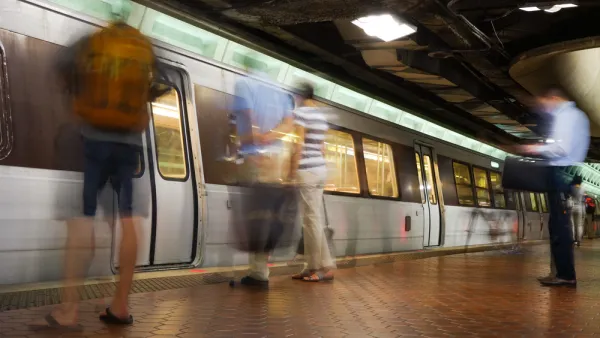With housing and transportation as the two biggest sources of carbon emissions, a new report shows how boosting density near transit would accelerate emissions reductions.

A report from the nonprofit Transit Forward indicates how Austin could meet its transportation and climate goals by supporting increased housing density, reports Nina Hernandez in Austin Monitor. “The report includes climate projections for Austin and then outlines how housing density and transit can help ease those impacts by reducing greenhouse gas emissions.”
The report notes that “the average carbon footprint for a single-family household is 100 pounds of CO2 per square meter. Dense housing units closer to the city center have lower carbon footprints.” On a map showing carbon footprints by neighborhood, the University of Texas’ West Campus numbers among the areas with the lowest average footprint. In the United States, college campuses are one rare example of walkable, mixed-use communities with dense housing and plenty of opportunities to access daily needs without a car.
The report’s recommendations include increasing housing density coupled with access to mobility and boosting local transit systems. According to Bill McCamley, executive director of Transit Forward, “We need more transit and we need more dense housing near transit because housing and transit combined, they’re number one and number two in terms of greenhouse gas emissions.”
FULL STORY: Report suggests Austin reach net-zero climate goals via housing density and increased transit

National Parks Layoffs Will Cause Communities to Lose Billions
Thousands of essential park workers were laid off this week, just before the busy spring break season.

Retro-silient?: America’s First “Eco-burb,” The Woodlands Turns 50
A master-planned community north of Houston offers lessons on green infrastructure and resilient design, but falls short of its founder’s lofty affordability and walkability goals.

Delivering for America Plan Will Downgrade Mail Service in at Least 49.5 Percent of Zip Codes
Republican and Democrat lawmakers criticize the plan for its disproportionate negative impact on rural communities.

Test News Post 1
This is a summary

Test News Headline 46
Test for the image on the front page.

Balancing Bombs and Butterflies: How the National Guard Protects a Rare Species
The National Guard at Fort Indiantown Gap uses GIS technology and land management strategies to balance military training with conservation efforts, ensuring the survival of the rare eastern regal fritillary butterfly.
Urban Design for Planners 1: Software Tools
This six-course series explores essential urban design concepts using open source software and equips planners with the tools they need to participate fully in the urban design process.
Planning for Universal Design
Learn the tools for implementing Universal Design in planning regulations.
EMC Planning Group, Inc.
Planetizen
Planetizen
Mpact (formerly Rail~Volution)
Great Falls Development Authority, Inc.
HUDs Office of Policy Development and Research
NYU Wagner Graduate School of Public Service





























